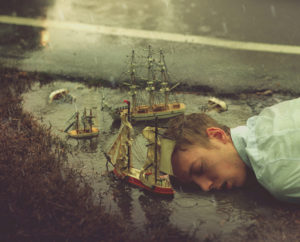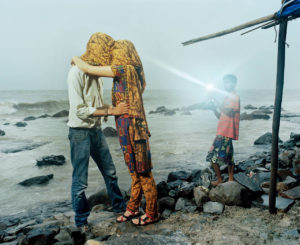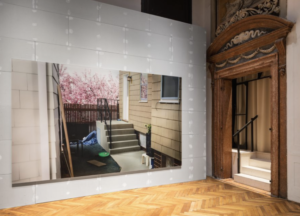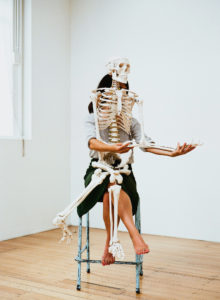Photography Studios: Semester 2, 2019
The BA Photography Studios for Semester 2, 2019 are described below. These are the options for the first and second year students be offered under the following course codes:
Photography Studio 1 VART 3593 (1st year)
Photography Studio 3 VART 3597 (2nd year)
Please read them carefully and decide upon your first, second and third preferences.
Provided you are enrolled in one of these courses, you will be able to nominate your preferences through myTimetable between 17 June and 1 July, 2019.
IMPORTANT – You must not repeat Studios and you must enter three different preferences. Every effort will be made to place you in your first or second preference. Allocations are made on the basis of space available and group balance, with the higher year level being given priority (i.e it is not 'first come, first served').

Kyle Thompson, The sinking Captain, 2012
1. Making Do: DIY Constructed Photography
Fiction reveals truth that reality obscures. Jessamyn West, 1957
If you don't have the right equipment for the job, you just have to make it yourself. MacGyver (Richard Dean Anderson) 1985
When thinking about photography, we’ve often focused on its lingering association with truth, but what of the potentials of fiction?
Our susceptibility to photography’s compelling illusion of evidence makes a great argumentative tool, and an ideal way to tell stories. Constructed photography, tableaux, collage provide ways to exploit the tensions between truth and fiction in that the medium ignites. Constructed or fictional photography also allows us to bypass restrictions imposed by the media, the state, budget or geography.
An area of focus will entail responding to what is at hand or easily and cheaply available, drawing on particular qualities of the medium to persuade an audience to suspend their disbelief. Expensive sets, a cast of actors and models, airfares to exotic locations don't necessarily ensure great work. Rather, we'll make do with our friends and what we have at hand.
Exercises and tasks aim to cultivate creative responses to the problems we set ourselves. Lectures and workshops will focus on short term tasks and a semester long, student-initiated research folio project.
aims- Engage with modes of photo story telling beyond the merely descriptive.
- Explore tensions between fiction and truth in photography.
- Cultivate creative thinking and the development of novel strategies.

Jo Cicluna & Vivian Cooper Smith, Point Farewell - Cape Schanck #2, 2014
2. Contemporary Landscape
[landscape] doesn’t merely signify or symbolise power relations; it is an instrument of cultural power, perhaps even an agent of power that is (or frequently represents itself as) independent of human intentions. W.J.T. Mitchell, Landscape and Power, 2002
What are the ways in which landscape photographs can be made meaningful and relevant?
Historically, photography has been used as a tool to understand the world, shaping cultural perception. It is landscape photography that frames and constructs our view — or our projection — of nature. This studio is an enquiry into photomedia-based representations of nature — be that romantic and sublime landscapes, human altered landscapes, or artistic interventions into the landscape.
Students will engage with key theoretical discourses aimed at expanding understanding and practice of issues around the nature-culture relationship while learning fundamentals for photographing and constructing landscape imagery. Learning activities will include lectures, reading and discussion, presentations, critique, and fieldwork.
aims
• Develop technical, conceptual, and aesthetic skills for photographing landscape issues.
• Develop a basic understanding of the critical discourse around landscape photography.
• Develop and refine the ability to be self-reflective and critically evaluate landscape images.
**Further Information This Studio includes an overnight long weekend field trip (3-4 nights) in the second half of the semester. It is expected that students will arrange their schedules and pay the necessary but modest expenses in order to participate.

Max Pinckers, from Will They Sing Like Raindrops or Leave Me Thirsty, 2015
3. Expanded Documentary: Collingwood Studio
The perpetual doubt, the nagging insecurity – whether what we see is ’true’, ’real’, ’factual’ and so on – accompanies contemporary documentary reception like a shadow. Let me suggest that this uncertainty is not some shameful lack, which has to be hidden, but instead constitutes the core quality of contemporary documentary modes as such. Hito Steyerl, Documentary Uncertainty, 2011
What are the limits of documentary practice?
This studio is a critical inquiry into the role of documentary practice in a ‘post-truth’ moment, and the different ways in which photographers can work with the ‘facts of the world’. The postmodern critique of photojournalism and documentary practice produced essential debates on ethics, aesthetics, privilege, representation, and authorship, and this visibly shifted the practice and aesthetics of documentary. A focus on power structures and systems rather than individual victims, long-form research-based work rather than parachute approaches to journalism, and collaboration and self-representation, rather than the myth of the solo auteur represent some of these shifts.
In this studio we will design a series of documentary projects with the Collingwood community, while attending to key debates surrounding the politics of aesthetics and representation. The work may take the form of a narrative, investigation, or social critique. Lectures, fieldwork and readings will introduce documentary modes, historical and contemporary debates, and examples of contemporary practice. Our projects will result in the publication of a newspaper that we will distribute in Collingwood.
aims
- Develop a project for publication.
- Develop an ethical framework through which to practice.
- Demonstrate an applied critical understanding of the politics of representation and collaborative practices.
**Further Information
This studio will run at Collingwood as part of our Photo Futures Lab. Students will have access to an individual workspace, a community of artists in residence and printing facilities. While a high level of commitment and initiative is required, it will also be fun.

Thomas Demand, Backyard, 2014
4. Site Specific
As site-specific art intersected with land art, process art, performance art, conceptual art, installation art, institutional critique, community-based art, and public art, its creators insisted on the inseparability of the work and its context. Miwon Kwon
In what types of spaces, situations and contexts can you make work to be encountered?
This studio is an investigation into site-specific practices with an importance placed on understanding that sites have political, economic and social agency. In this course, you will learn about different types of site-specific projects through lectures, site visits, workshops and group critiques. Site-specific exhibition making frames the presentation of work as an unfolding event and is concerned with the process of making work for a space, its context and the situation in which the work exists.
Through a self-reflective process, students will propose to make site-specific photographic work with consideration to the location, the medium of the artwork (printed on paper, fabric, aluminium, wood, etc.), and how the project will be encountered. You may propose to make artwork for a white cube, a set design, as a window display, on the body, in editorial, in an urban or rural setting, or in the blurry boundaries of the public space.
aims- Develop technical, conceptual, and aesthetic skills to produce work for a specific site.
- Develop a basic understanding of the critical discourse around site-specific art practice.
- Develop skills that assist you to determine where to present your work and how it is encountered.

Clare Rae, Untitled Self Portrait, 2019
5. Performative Photography & the Body
The self portrait photograph then becomes a kind of technology of embodiment and yet one that paradoxically points to our tenuousness and incoherence as living, embodied subjects. Amelia Jones, 2002
How can performative photography complicate notions of identity and subjectivity?
This studio will explore the history of staged and performative photography, surveying a field of practitioners who engage photography to explore performance, the body, identity and sexuality. Throughout the semester we will consider current debates and issues around performance and documentation (the liveness debate and re-mediation), the politics of self-representation, the artist’s body and phenomenology, and the complexities inherent in the photographic process of self-imaging.
Students will initially formulate a question to shape their research, which will then inform the visual outcomes. Through consultation and peer discussion students will propose and develop a photographic project utilising an aspect of performativity or the body to address their research interests. The studio will be delivered through a mix of lectures, tutorials, readings and responses, workshops and critiques.
aims- Introduce students to a range of contemporary artists working in relevant fields.
- Develop a research methodology to inform the production of artwork.
- Develop an understanding and awareness of current discourse and applicable photographic theory and critique.

Jerry Galea, Global Future
6. A Question of Truth: Photojournalism & Editorial Photography
New technologies and social media platforms have unlocked endless opportunities for greater exposure and influence audiences, but not everyone has a photojournalistic eye and understands media-driven images.
What does photojournalism do, what are it’s inadequacies and what does it look like in the 21st century?
This studio focuses on narrative-driven images for news, media outlets and the magazine industry. Online and social media platforms have changed the nature of photojournalism; both local and global issues are now embedded into our everyday lives. We need to consider that these images have an inherent tendency to pose viewpoints about the world that are contentious. With sensitive curation on the part of the photographer, these 'events' can provide audiences with insight, context and possibly the means to an empathetic relationship with unfamiliar experiences of others. A photojournalist therefore needs to understand news values, such as currency, timeliness, human interest and conflict, all often captured in a single image.
The learning outcomes for this studio seeks to give you an understanding of what it is like to work in these industries in the 21st century. Underpinned by an ethical framework, students will produce thought-provoking images with strong visual language. You are expected to research and develop story ideas that engage, inform and challenge audiences. You will also work collaboratively to develop a multimedia production which will include moving images, still images, sound recording, and text.
aims- Produce a collaborative multimedia project.
- Develop an ethical framework for production and dissemination of news-driven images.
- Develop a visual language that underpins your practice.
- Understand news, feature and media related imagery.

Greg Penn, Totally Unloaded, 2018
7. 21st Century Photography
The digital photo is always ‘retouched’ or processed, in that it depends on an image-processing programme to make it visible. The computer has overtaken the camera in importance, and the lens has become incidental to the capturing of an image. Conventional photography was defined by the notion of the trace produced by visible appearances of reality. Photo-realist systems of digital synthesis have replaced the notion of the trace with a traceless record that vanishes in a spiral of mutations. Joan Fontcuberta, Pandora’s Camera, 2014
What is photography in the 21st century?
Photography has experienced unprecedented change as mediums unravel, merge and collapse into a vast hybrid mesh of possibilities. We are witness to photography’s expansion, connecting with moving image, sound, sculpture, installation, performance, drawing, painting, writing and many other forms. This is an incredible period in which to consider what we mean by ‘photography’. The medium has a rich history of experimentation, from the avant-garde of the1920s to conceptual art of the 1960s through to the 1980s and the rise of new media. Today we are fortunate enough to combine all this knowledge with digital and ever-expanding technological discoveries.
Through a wide variety of explorations and experimentations, students will be able to expand their conceptual possibilities and approaches to photography by considering how new techniques and old traditions merge and align with their own individual practice, connecting and enriching their image-making experience. They will explore unknown territories and absorb valuable insights into what it means to be a photographer today.
aims
- Consider what being a photographer means in the 21st Century.
- Position oneself in the dynamic image world as a confident and inquiring image producer.
- Develop skills and expand beyond the conventional definitions that have traditionally framed photography.
**Please note This Studio is unrelated to 'The Professional Studio in the 21st Century' taught by Chris Budgeon and Pauline Anastasiou in Semester 1, 2018.